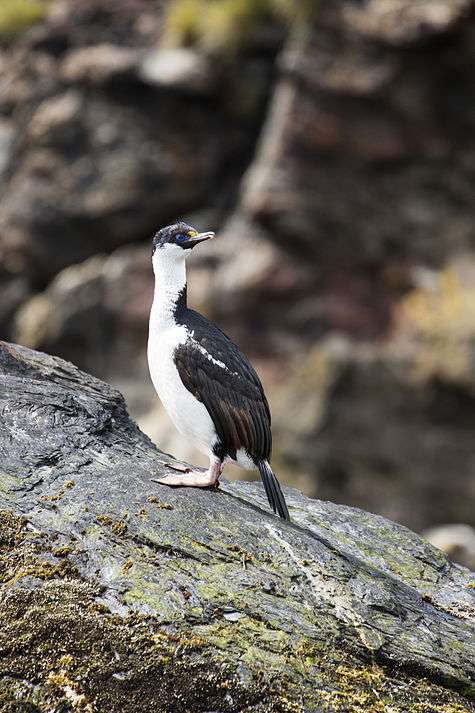Blue-eyed shag
| Blue-eyed shags | |
|---|---|
| | |
| South Georgia shag Phalacrocorax (atriceps) georgianus | |
| Scientific classification | |
| Kingdom: | Animalia |
| Phylum: | Chordata |
| Class: | Aves |
| Order: | Pelecaniformes |
| Family: | Phalacrocoracidae Reichenbach, 1850 |
| Genus: | Phalacrocorax (but see text) Brisson, 1760 |
| Species | |
|
8–14, see text | |
| Synonyms | |
|
Euleucocarbo | |
The blue-eyed shags are a flock of birds closely related cormorant taxa. All have a blue, purple or red ring around the eye (not a blue iris); other shared features are white underparts (at least in some individuals) and pink feet.[1]
They are found around the colder parts of the Southern Hemisphere, especially near southern South America, Antarctica, and New Zealand. Many are endemic to remote islands. Determining which types are species and which are subspecies of what larger species is problematic; various recent authorities have recognized from 8 to 14 species and have placed them in a variety of genera. The common names are even more confusing, "like myriad footprints criss-crossing in the snow and about as easy to disentangle." Only one common name is given for most species here.[1]
Delimiting this group after Nelson but assigning species limits after HANZAB gives the following species list, divided into two "complexes":
- Imperial shag or blue-eyed shag, Phalacrocorax atriceps
- White-bellied shag or king cormorant, Phalacrocorax (atriceps) albiventer
- Antarctic shag, Phalacrocorax (atriceps) bransfieldensis
- South Georgia shag, Phalacrocorax (atriceps) georgianus
- Heard shag, Phalacrocorax (atriceps) nivalis
- Crozet shag, Phalacrocorax (atriceps) melanogenis
- Macquarie shag, Phalacrocorax (atriceps) purpurascens
- Kerguelen shag, Phalacrocorax (atriceps) verrucosus
- King shag or rough-faced shag, Phalacrocorax carunculatus
- Otago shag, Phalacrocorax chalconotus
- Foveaux shag, Phalacrocorax stewarti
- Chatham shag, Phalacrocorax onslowi
- Auckland shag, Phalacrocorax colensoi
- Campbell shag, Phalacrocorax campbelli
- Bounty shag, Phalacrocorax ranfurlyi
If Leucocarbo is considered a distinct genus (which would probably require splitting up Phalacrocorax for the largest part), the Guanay cormorant would also seem to belong here; alternatively, Leucocarbo could be expanded by several American species (including the flightless cormorant and rock shag).[2] See Cormorant species in phylogenetic sequence for further information.
References
- 1 2 Nelson, J. Bryan (2006), Pelicans, Cormorants, and Their Relatives: The Pelecaniformes, Oxford University Press, U.S.A., pp. 476–511, Plate 8, ISBN 978-0-19-857727-0
- ↑ Kennedy, M.; Gray, R.D. & Spencer H.G. (2000). The Phylogenetic Relationships of the Shags and Cormorants: Can Sequence Data Resolve a Disagreement between Behavior and Morphology? Molecular Phylogenetics and Evolution 17(3): 345-359. doi:10.1006/mpev.2000.0840 PDF fulltext
